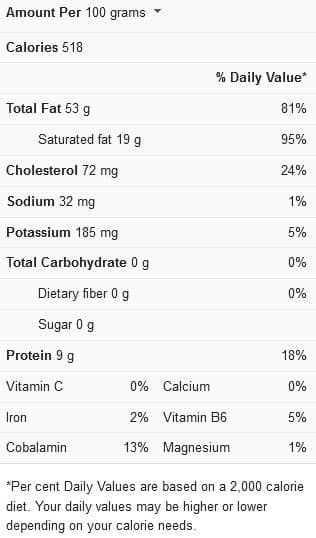One of the keys to a delicious pork belly ramen meal is getting the pork belly right. The ideal results should be deliciously tender and juicy, not soggy but not so chewy either. Cooking pork belly correctly is however not so easy, especially if you’re not sure about the right cooking instructions to follow.
In this article, we’ll show you the best way to cook your pork belly, so that when you use it in your ramen, the results will be incomparable. Make sure to take note of all the helpful tips and instructions we’ve outlined in this article for the best results.
Pork Belly Nutrition Facts

Tips for cooking pork belly for ramen
Pay attention to the following helpful tips and guidelines in order to achieve the best results when cooking pork belly for ramen:
Roll and tie up your pork belly – You might ask yourself what the exact purpose of rolling the pork belly is before frying it. The following are the reasons to roll up and tie your pork belly:
- To keep the form after the fat has been rendered.
- To lock in moisture and keep the pork meat wet (because it is protected by the rind this way).
- To maintain an attractive appearance on the meat after cooking.
Follow these easy steps to correctly roll and tie up your pork belly:
- Determine the best rolling orientation. One or both of the rolled ends should resemble bacon, with the varied layers of flesh and fat visible.
- Roll up the pork belly and figure out how much of the meat you’ll need for your recipe. Any excess meat can be saved and used in other dishes.
- Once the pork belly has been rolled into a log, wrap it with butcher twine across one end, then tie a double knot.
- Wrap the same end (the beginning point) 2 to 3 more times to ensure it is secure.
- Then wrap the twine 2 to 3 times securely across the far end of the log. Both ends of the pork belly log should be properly secured by now.
- Start wrapping securely from this point and work your way back to the beginning, leaving ⅓ inches (1 cm) in between each of the wraps.
- Thread the twine under some of the wraps around the middle area of the pork belly log after you’ve reached the starting point, then bring it back to the starting position.
- Use the ends of the butcher’s twine to create a double knot.
At this point, you have successfully rolled up your pork belly into a log, so all the moisture will be locked in and you can expect really juicy results.
Ideas for improved flavor – It’s best to roast the pork belly first to add depth and flavor, then separate the bones from the soft meat and make a lovely broth with them.
The ramen broth is the foundation of any good ramen. Use dried kelp (kombu), Bonito flakes, or Miso to infuse as much flavor as possible into the pork belly and the broth. Dashi, a Japanese stock made with Kombu, Bonito, or Niboshi (anchovies/sardines), is also great since it gives the soup a real punch. Cooking the soup with bones from the pork belly serves to greatly enrich and add meaty umami to the broth.
How to reheat pork belly before use in ramen – Cooked pork belly can be warmed up for further use in three different ways:
- You can soak the pork belly in the heated cooking sauce and heat it up.
- Add the cooked pork belly straight into the heated noodle soup.
- Using a kitchen butane flame, sear the pork belly.
To reheat your pork belly and introduce a delicious smoky charred taste, use the searing option. It’s important to remember to top the pork belly with some of the hot cooking liquid!
Cooking time for pork belly
The ideal timing guidelines for cooking pork belly have been described in the table below:
| Cooking procedure | Cooking time |
| Cooking pork belly in the oven at 275 degrees Fahrenheit | 3 to 4 hours |

Chashu pork (Marinated braised pork belly for tonkotsu ramen) (6 to 8 servings)
Ingredients
- 2-pound slab of boneless pork belly, skin-on
- ½ cup of soy sauce
- 1 cup of sake
- 1 cup of mirin
- ½ cup of sugar
- 6 scallions, roughly chopped
- 6 whole garlic cloves
- One 2-inch knob of ginger, roughly sliced
- 1 whole shallot, split in half (skin on)
Instructions
- Place the pork belly atop a cutting board and wrap it up lengthwise, with the skin facing outwards.
- Bind the pork belly tightly at ¾-inch intervals with butcher’s twine.
- Heat up your oven to 275 degrees Fahrenheit. In a medium saucepan, bring 1 cup of water, sake, soy sauce, sugar, mirin, scallions, ginger, garlic, and shallot to a boil over high heat. The pork belly should be added to this mixture (it should not be submerged). Cover it, but ensure that the lid is a little ajar.
- Cook the pork belly in the preheated oven, rotating it occasionally, for 3 to 4 hours, or until pork is thoroughly cooked and a thin knife or a cake tester pushed into its center meets no resistance.
- Refrigerate the ingredients after moving them into an airtight container until totally cool.
- Remove the pork belly and drain the soup as soon as you’re ready to serve. Save the broth for use later (a recipe like ajitsuke Tamago will benefit greatly from the pork belly broth). The pork belly should be sliced into tiny rounds (first cutting it in half lengthwise is a good idea).
- Heat up the pork belly slices with noodles or any other garnishes in soup stock. Optionally, you can heat up the pork belly with a blowtorch, charring the surface, or warm a little amount of the leftover stock inside a skillet and cook the pork slices in the broth until they get hot. Serve and enjoy them afterward.
Pork belly is always a wonderful addition to ramen, and when cooked properly, the possibilities for flavor are limitless. Follow the cooking instructions outlined above carefully in order to get the best results out of your cooking.
If you’re interested in more recipe ideas for pork belly, ensure to check out this video recipe.
